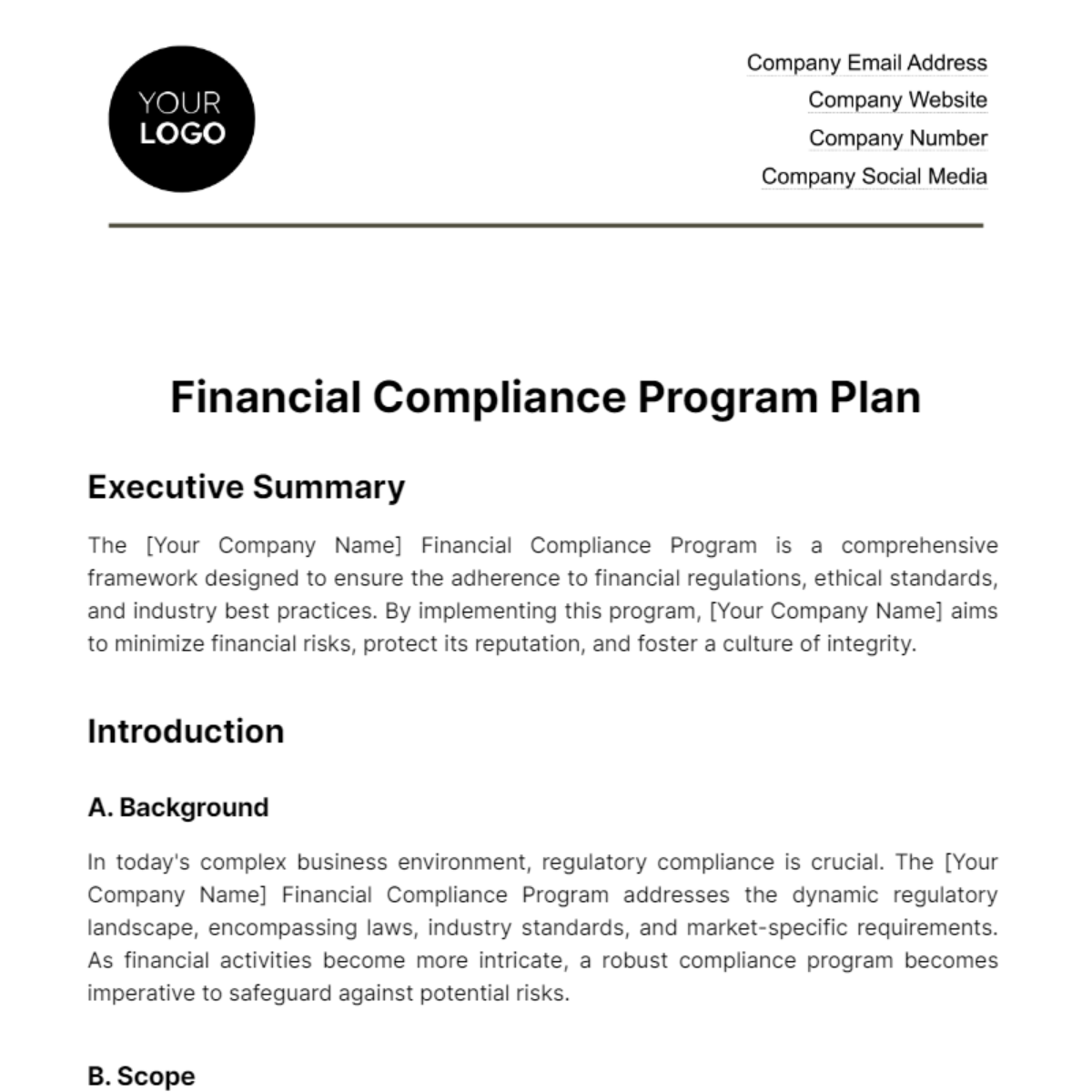Free Financial Compliance Program Plan

Executive Summary
The [Your Company Name] Financial Compliance Program is a comprehensive framework designed to ensure the adherence to financial regulations, ethical standards, and industry best practices. By implementing this program, [Your Company Name] aims to minimize financial risks, protect its reputation, and foster a culture of integrity.
Introduction
A. Background
In today's complex business environment, regulatory compliance is crucial. The [Your Company Name] Financial Compliance Program addresses the dynamic regulatory landscape, encompassing laws, industry standards, and market-specific requirements. As financial activities become more intricate, a robust compliance program becomes imperative to safeguard against potential risks.
B. Scope
The scope of the Financial Compliance Program covers all financial operations, transactions, and reporting within [Your Company Name]. This includes but is not limited to, financial planning, budgeting, accounting, taxation, and auditing processes. All employees, stakeholders, and relevant departments fall under the purview of this program.
Governance and Oversight
A. [Your Company Name] Compliance Committee
The [Your Company Name] Compliance Committee is a dedicated internal body responsible for overseeing and managing the effectiveness of the Financial Compliance Program. Chaired by [Your Name], the committee comprises key stakeholders from various departments. Its primary functions include policy review, risk assessment, and ensuring ongoing compliance education.
B. Compliance Officer
As the appointed Compliance Officer, [Your Name] is tasked with ensuring day-to-day compliance activities. Reporting directly to the executive leadership, [Your Name] is responsible for implementing and enforcing compliance policies, conducting risk assessments, and serving as the point of contact for any compliance-related concerns.
Risk Assessment
A. Identification of Financial Risks
To identify financial risks, [Your Company Name] employs a systematic approach that includes reviewing historical data, analyzing industry benchmarks, and consulting with subject matter experts. By staying informed about potential risks, the company can proactively address and mitigate these challenges.
B. Risk Analysis
Risk analysis involves quantifying identified risks using a comprehensive risk matrix. This matrix considers the impact and likelihood of each risk, allowing [Your Company Name] to prioritize its efforts. High-priority risks are addressed promptly through targeted mitigation strategies.
Policies and Procedures
A. Policy Development
Policies within the Financial Compliance Program are developed and regularly updated to align with the ever-evolving regulatory landscape. [Your Company Name] ensures that policies are clear, concise, and accessible to all employees. Continuous monitoring ensures that policies remain up-to-date and relevant.
B. Procedure Documentation
A critical component of the program is the documentation of procedures. As an example, the Financial Reporting Procedure outlines the steps involved in accurate and timely financial reporting. This documentation serves as a guide for employees, ensuring standardized processes across the organization.
Training and Awareness
A. [Your Company Name] Training Program
To foster a culture of compliance, [Your Company Name] conducts regular training sessions for all employees. These sessions cover key aspects of financial compliance, including policy updates, regulatory changes, and case studies. Ongoing education ensures that employees are well-informed and capable of making complaint decisions.
B. Communication Plan
A robust communication plan is in place to disseminate information regarding policy changes, procedure updates, and regulatory developments. Through various channels such as company-wide emails, intranet postings, and training sessions, [Your Company Name] ensures that employees are consistently informed.
Monitoring and Testing
A. Internal Controls
Internal controls are implemented to monitor financial activities and ensure compliance. Regular reviews and assessments are conducted to verify the effectiveness of these controls. For instance, segregation of duties is enforced to prevent unauthorized access to critical financial systems.
B. Audits and Reviews
Internal and external audits are scheduled periodically to assess the adherence to the Financial Compliance Program. The Audit Schedule details the frequency and scope of audits. Findings from audits are used to refine and enhance compliance measures.
Reporting
A. Incident Reporting
The incident reporting process allows employees to report any observed or suspected compliance violations. An Incident Report Template is provided to streamline the reporting process. Timely reporting enables [Your Company Name] to investigate and address issues promptly.
B. [Your Company Name] Compliance Report
A comprehensive compliance report is generated periodically to provide an overview of the program's effectiveness. This report includes key metrics, compliance trends, and areas for improvement. The [Your Company Name] Compliance Report is shared with the executive leadership and relevant stakeholders.
Continuous Improvement
A. Lessons Learned
An essential aspect of the Financial Compliance Program is learning from past incidents. Lessons learned are documented, and corrective actions are implemented to prevent similar occurrences. This continuous improvement process enhances the overall effectiveness of the program.
B. Program Evaluation
Regular evaluations are conducted to measure the effectiveness of the Financial Compliance Program. Key performance indicators (KPIs) and metrics, are tracked to assess the program's impact on mitigating risks and fostering a compliant culture.
Conclusion
The [Your Company Name] Financial Compliance Program is a proactive approach to managing financial risks and ensuring ethical business practices. Through robust governance, comprehensive policies, ongoing training, and continuous improvement, [Your Company Name] is committed to maintaining the highest standards of financial compliance.
For any inquiries or further information, please contact [Your Name] at [Your Company Email] or [Your Company Number].
- 100% Customizable, free editor
- Access 1 Million+ Templates, photo’s & graphics
- Download or share as a template
- Click and replace photos, graphics, text, backgrounds
- Resize, crop, AI write & more
- Access advanced editor
Implement robust compliance programs with the Financial Compliance Program Plan Template on Template.net. This editable and customizable plan simplifies program development. Tailor content effortlessly using our Ai Editor Tool, ensuring adaptability and precision. Elevate your compliance strategies with this user-friendly template, offering a comprehensive approach to crafting personalized program plans for informed decision-making and strategic compliance management.





























